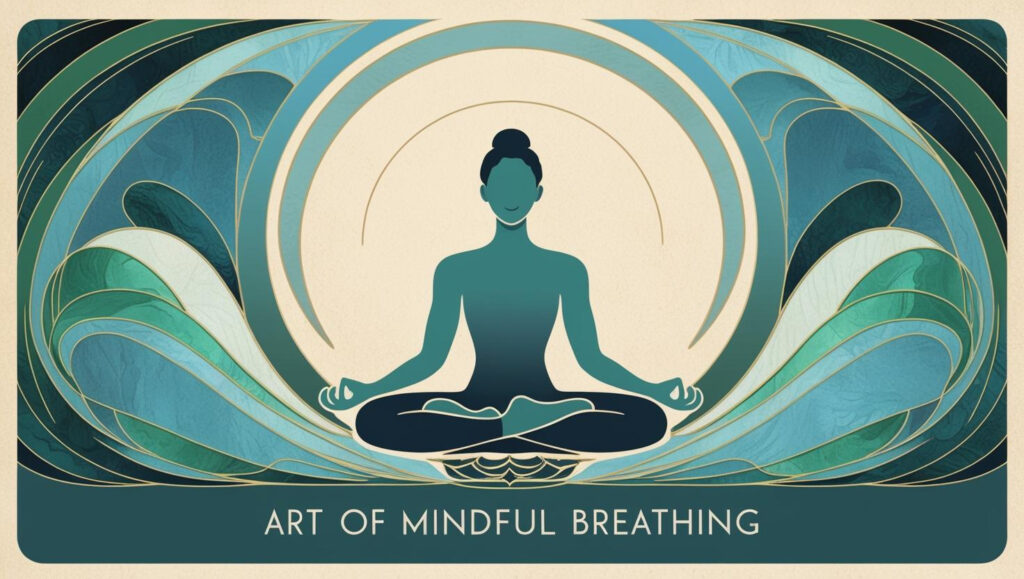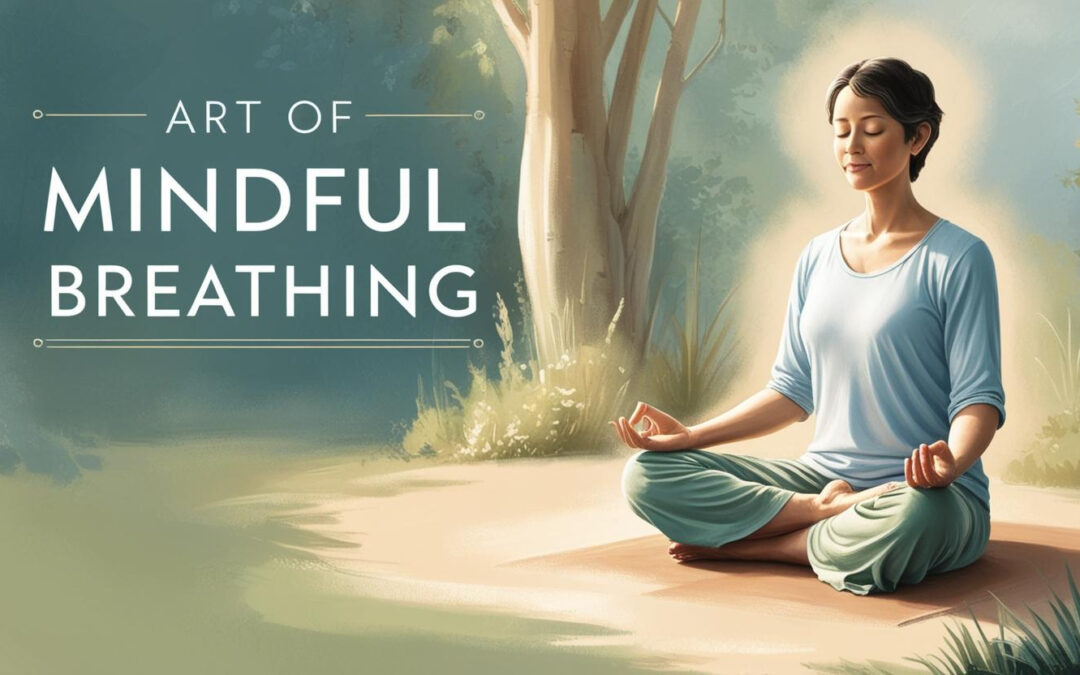Mindful Breathing is an incredible tool that can transform your daily life. Whether you’re feeling overwhelmed, unfocused, or just seeking a little peace, learning to breathe mindfully can be a game-changer. Let’s explore amazing breathing techniques like box breathing and diaphragmatic Breathing. These techniques help reduce stress, sharpen your focus, and contribute to your overall well-being. 🌈
Imagine taking a moment to pause, breathe deeply, and feel that tension melt away! Sounds impressive, right? In this article, we’ll guide you through each step of these exercises, making it simple and fun for you to practice and experience the benefits firsthand. Get ready to embrace calmness and clarity like never before!
Understanding Mindful Breathing
Mindful Breathing is an ancient practice rooted in both meditation and modern psychology, designed to bring awareness to your every breath. This practice not only calms the mind but also enhances your overall well-being. Understanding mindful Breathing allows you to connect deeply with your body, bringing you into the present moment with a sense of clarity and peace.
The Concept of Mindfulness in Breathing
Mindfulness in Breathing involves paying attention to the way you breathe in and out without trying to change it. It centers on being present and fully experiencing each breath. This means observing the flow of air, the movement in your lungs, and perhaps even noticing how your body responds with each inhale and exhale. By intentionally focusing your attention, you cultivate a greater awareness of your thoughts and emotions, thus improving emotional regulation and reducing stress.
Mindfulness practices have been shown to increase concentration and emotional peace while diminishing anxiety and depression. With mindful Breathing, the goal is to maintain a gentle focus on each breath, gradually letting go of distractions and returning the mind to a calm state of awareness.
The Science Behind Breathing Techniques
Science reveals that breathing techniques have physiological impacts, influencing the nervous system and stress response. Experts note that when these techniques are practiced regularly, they can significantly improve mental and physical health.
How Breathing Affects the Nervous System
Breathing directly impacts the autonomic nervous system (ANS), which is responsible for regulating involuntary body functions like heart rate and digestion. When you breathe deeply and slowly, you activate the parasympathetic nervous system (often termed the “rest and digest” system), leading to a state of relaxation.
Conversely, shallow or rapid Breathing can activate the sympathetic nervous system, which is the “fight or flight” response. Different breathing patterns can thus either alleviate or escalate feelings of stress and anxiety. Understanding these patterns helps manage emotional states and achieve a balanced nervous system.
The Role of Breathing in Stress Reduction
In the realm of stress reduction, Breathing serves as a powerful tool. It interrupts the stress cycle, allowing the body to shift back into a state of relaxation. Techniques such as box breathing and diaphragmatic Breathing are particularly effective in reducing stress by promoting calmness through deliberate and structured breathing cycles.
Scientific research underscores that controlled Breathing can lower the production of stress hormones like cortisol. Therefore, participating in regular breathing exercises can enhance one’s ability to cope with stress, leading to improved mental and emotional resilience over time.
In essence, mindful Breathing is both an art and science, offering profound benefits for those seeking peace, clarity, and a deeper connection with themselves. By understanding and incorporating these breathing practices into daily life, individuals can embark on a transformative journey toward enhanced well-being.
Different Types of Breathing Techniques
Understanding various breathing techniques can significantly enhance your overall well-being. Here’s a closer look at some popular methods, including Box Breathing, Diaphragmatic Breathing, and Alternate Nostril Breathing.
Box Breathing
Box Breathing is a simple yet incredibly effective breathing technique. It consists of four equal parts and helps to promote calmness and focus.
Steps to Practice Box Breathing
To practice Box Breathing, you can follow these steps:
- Inhale: Breathe in slowly through your nose for a count of four.
- Hold: Hold your breath for a count of four.
- Exhale: Breathe out slowly through your mouth for a count of four.
- Hold: Pause and hold your breath for another count of four.
Repeat the cycle for about five minutes to achieve a state of deep relaxation.
Benefits of Box Breathing
Box Breathing provides several benefits, including:
- Stress Reduction: This technique can significantly reduce stress levels by stopping your body’s ‘fight or flight’ response.
- Enhanced Focus: By concentrating on the rhythm of your breath, Box Breathing can improve mental clarity and concentration.
- Improved Mood: Regular practice can lead to a more balanced emotional state.
Diaphragmatic Breathing
Diaphragmatic Breathing, also known as abdominal or belly Breathing, involves fully engaging your diaphragm. It maximizes the amount of oxygen that enters your body with each breath.
Steps to Practice Diaphragmatic Breathing
To practice Diaphragmatic Breathing, follow these steps:
- Position: Lie down on your back with your knees bent or sit comfortably. Place one hand on your chest and the other on your abdomen.
- Inhale: Take a slow, deep breath in through your nose, allowing your belly to rise, not your chest.
- Exhale: Breathe out slowly through your mouth as your belly lowers.
Practice for five to ten minutes daily to harness its full benefits.
Benefits of Diaphragmatic Breathing
Diaphragmatic Breathing offers numerous benefits:
- Reduced Anxiety: It helps in controlling and reducing anxiety symptoms by promoting relaxation.
- Better Sleep: Practicing before bedtime can improve sleep quality.
- Increased Lung Function: It can enhance the efficiency of your lungs, allowing for deeper, more effective Breathing.
Alternate Nostril Breathing
Alternate Nostril Breathing is a popular yoga practice known as Nadi Shodhana. It balances the flow of energy throughout your body.
Steps to Practice Alternate Nostril Breathing
To practice Alternate Nostril Breathing, follow these steps:
- Position: Sit comfortably with your spine straight.
- Position Fingers: Use your right thumb to close your right nostril.
- Inhale: Breathe in deeply through your left nostril.
- Switch: Close your left nostril with your ring finger, and release your thumb from the right nostril.
- Exhale: Exhale slowly through the open right nostril.
Continue the cycle for a few minutes, ending with an exhalation from the left nostril.
Benefits of Alternate Nostril Breathing
The benefits of this technique include:
- Calming Effects: It brings calmness to the mind and body, reducing stress and anxiety.
- Improved Cardiovascular Function: It promotes cardiovascular health by encouraging full, deep Breathing.
- Balance and Harmony: Regular practice can restore balance and harmony to your body’s systems.

Breathing Techniques for Stress Reduction
Breathing techniques for stress reduction are potent tools that can help calm the mind and body. Focusing on the breath can alter our physiological state, promoting relaxation and peace. Various techniques are known to reduce stress effectively and can be practiced anywhere, at any time.
How Breathing Enhances Relaxation
How Breathing enhances relaxation is rooted in the body’s natural responses. When we engage in deep, rhythmic Breathing, we activate the parasympathetic nervous system. This system is responsible for the “rest and digest” responses, counteracting the “fight or flight” reaction associated with stress.
Slow and intentional breaths help lower heart rate, reduce blood pressure, and decrease the production of stress hormones like cortisol. Additionally, focusing on the breath can shift our attention away from stress-inducing thoughts, fostering mental tranquility.
Breathing Exercises to Combat Stress
Breathing exercises to combat stress can offer immediate relief and instill a sense of calm. These exercises are easy to perform and require no special equipment. Here are two practical exercises you can incorporate into your routine.
Quick Stress Relief Breathing Exercise
The quick stress relief breathing exercise is designed to quickly bring about a sense of calm. To perform it, follow these steps:
- Find a comfortable position: Sit or stand with your back straight and shoulders relaxed.
- Close your eyes gently: This helps reduce distractions.
- Inhale deeply through the nose: Count to four as you fill your lungs with air.
- Hold your breath: Pause for a moment, counting to two.
- Exhale slowly through the mouth: Count to six as you release the breath completely.
- Repeat: Do this cycle for about 1-2 minutes.
This exercise helps activate a relaxation response, reducing stress and tension in the body and mind.
Guided Breathing for Relaxation
Guided Breathing for relaxation incorporates visualization and mindfulness, enhancing its soothing effects. Here’s how to perform this exercise:
- Settle into a relaxed position: You can sit or lie down comfortably.
- Visualize a peaceful place: Picture yourself in a calming environment like a beach or forest.
- Focus on your Breathing: Inhale deeply through your nose, imagining fresh air filling your lungs.
- Hold your breath for a moment: Allow the tranquility of your imagined place to fill you.
- Exhale slowly: Picture tension and stress leaving your body with the breath.
- Continue for 5-10 minutes: Repeat the cycle, allowing yourself to fully immerse in the peaceful imagery.
This guided breathing technique reduces stress, elevates your mood, and improves overall well-being.
Incorporating these breathing exercises into your daily routine can cultivate a more stress-free lifestyle and bolster your emotional resilience.
Breathing Techniques for Improved Focus
Mindful breathing techniques are powerful tools that can enhance focus and concentration. These techniques can help you meet life’s challenges with clarity when practiced regularly. Let’s uncover how focusing on your breath can sharpen your mind.
The Connection Between Breath and Focus
When you focus on Breathing, you draw your attention away from distractions and bring your mind to the present moment. The act of mindful Breathing slows your respiratory rate, which can lower your heart rate and reduce anxiety. This physical calming effect helps to clear your mind and heightens mental clarity.
Scientific studies have shown that when our Breathing is steady and controlled, the brain enters a state of relaxation yet heightened attention. This state is ideal for maintaining focus on a task. Regular practice of mindful Breathing enables the brain to switch from the fight-or-flight to the rest-and-digest mode, optimizing conditions for improved cognitive skills.
Exercises to Enhance Concentration
Two particular exercises can help boost your concentration using focused Breathing: the Focusing Breath Exercise and Guided Meditation with Breathing.
Focusing Breath Exercise
The Focusing Breath Exercise is designed to enhance concentration by engaging the full capacity of your lungs and focusing your attention.
- Find a Comfortable Position: Sit upright in a chair with your feet flat.
- Slow Inhalation: Inhale slowly through your nose, filling your lungs completely for a count of 4.
- Hold the Breath: Hold your breath for a count of 4, concentrating on the sensation of fullness.
- Slow Exhalation: Exhale slowly through your mouth for a count of 6, letting go of any tension.
- Pause: Before the next inhale, pause for a count of 2.
- Repeat: Continue this cycle for 5-10 minutes, keeping your attention on the rhythm of your breath.
Practicing this exercise enhances your ability to sustain attention and bring your mind back to the task at hand whenever it wanders.
Guided Meditation with Breathing
Guided meditation incorporating breathing techniques is a structured way to increase your focus while also relaxing.
- Choose a Quiet Space: Ensure you are in a quiet and safe environment where you won’t be disturbed.
- Set a Timer: Decide on a duration for your meditation (5-20 minutes is ideal for beginners).
- Focus on Breathing: Close your eyes and begin with deep, slow breaths. Notice the rise and fall of your chest or the sensation of air entering your nostrils.
- Guided Visualization: Listen to a guided meditation audio that encourages focus on a single thought, word, or idea, using your breath as an anchor.
- Return to Breath: If your mind wanders, gently guide your focus back to your Breathing and the guided track.
Through Guided Meditation, regular practice can lead to improved attention span and mental clarity. This practice promotes focus and fosters an overall sense of peacefulness and well-being. Enjoy your journey on this path to sharper focus through the art of mindful Breathing.
Enhancing Well-being Through Mindful Breathing
Mindful Breathing is more than just a relaxation tool. It is a powerful practice that can enhance your overall well-being by promoting emotional balance and improving health. By integrating mindful Breathing into daily life, individuals can experience a profound shift in their mental and physical state.
Breathing for Emotional Balance
Breathing for emotional balance plays a crucial role in regulating our mood and responses to stress. When we practice mindful Breathing, we engage the parasympathetic nervous system, which helps offset the fight-or-flight responses triggered by stress. This activation results in a calmer, more balanced emotional state. Here’s how you can use your breath to find emotional equilibrium:
- Pause and Reflect: Whenever you feel overwhelmed, pause for a moment. Please take notice of your breath without trying to change it. This simple act of pausing helps to decouple your immediate emotional reaction from the situation at hand.
- Breath Counting: Inhale through your nose for a count of four, hold the breath for four, exhale for four, and pause for four before repeating. This is known as Box Breathing. It provides a structured focus that can ease anxiety and bring emotional stability.
- Emotional Awareness through Breathing: As you breathe mindfully, allow yourself to become aware of the emotions coursing through your body. Acceptance of these emotions while breathing deeply can foster a sense of peace and balance.
Remember, consistent practice is key. The more you engage in breathing exercises, the better you become at managingemotional responses.
Using Breath to Improve Health
Using breath to improve health is not just spiritual talk but has a solid base in science. Breathwork can enhance physical well-being by improving respiratory function, boosting oxygen flow, and promoting overall vitality. Here are some benefits and tips for using breath to boost health:
- Boosts Immunity: Deep Breathing increases oxygen supply to the cells, which may improve the functioning of your immune system.
- Increases Lung Capacity: Regular practice of deep breathing exercises helps in the expansion of lung capacity, leading to more efficient oxygen exchange.
- Promotes Cardiovascular Health: Slow and deep breaths can lower blood pressure, reduce heart rate, and improve heart health over time.
- Improves Sleep: Practicing mindful Breathing before sleep can relax your body and mind, thereby improving the quality of your rest.
For better health through Breathing, it’s advisable to make these practices a daily habit, especially in the morning for a fresh start or before bed for a calming effect.
Tips for Incorporating Breathing Practices Daily
Incorporating breathing practices into your daily routine is simpler than it seems. Here are some useful tips:
- Start Small: Begin with just five minutes a day. As you grow comfortable, gradually increase the time you dedicate to breathing exercises.
- Set Reminders: Use reminders on your phone to prompt you to take breathing breaks throughout the day.
- Integrate with Existing Routines: Pair breathing exercises with activities you already do, like brushing your teeth or during your daily commute.
- Stay Consistent: Make it a non-negotiable part of your day. Consistency will help solidify these practices as habits.
- Track Progress: Keep a journal noting how you feel before and after each exercise. Tracking can motivate you to maintain the practice.
Consistent mindful Breathing can lead to lasting improvements in well-being. Take small steps today for a healthier tomorrow.
Incorporating mindful Breathing into your life can be transformative. You can significantly enhance your overall well-being by focusing on breathing for emotional balance, using your breath to improve health, and integrating these practices daily.
Guided Breathing Exercises for Beginners
Embarking on the journey of guided breathing exercises can be both revitalizing and transformative. These exercises are designed to introduce beginners to the art of mindful Breathing, offering a simple yet effective way to enhance relaxation, focus, and overall well-being. This section will walk you through preparation, execution, and troubleshooting techniques to ensure you get the most out of your practice.
Preparing for Your Breathing Exercise
Preparation is key to getting the most out of your breathing exercise. Creating a calm and peaceful environment can significantly enhance the experience.
- Choose a Quiet Space: Select a location where you are unlikely to be disturbed. This could be a quiet room in your home or a peaceful spot in a garden.
- Wear Comfortable Clothing: Opt for loose-fitting clothes that allow free movement and comfort without any restrictions.
- Set the Mood: Dim the lights or play soft music if it helps you to relax. Some people find that lighting a candle or using essential oils enhances their sense of serenity.
- Find a Comfortable Position: You can lie down or sit with your back straight. If sitting, ensure your feet are flat on the ground, and your hands rest comfortably on your knees or in your lap.
- Set an Intention: Set a positive or calming intention before you start. This could be as simple as wanting to relax or seeking clarity.
Note: Having a clear intention helps center your mind and keeps you focused during the exercise.
Step-by-Step Guided Breathing
Engaging in a guided breathing session involves a sequence of steps designed to bring peace and focus.
- Begin with Awareness: Close your eyes and take a moment to simply be aware of your natural breathing pattern.Do not try to change it—observe its rhythm.
- Deep Inhale: Take a slow, deep breath through your nose. Feel your belly expand as you fill your lungs completely.
- Pause and Feel: Hold your breath gently for a moment. This pause helps to calm the mind and refresh the body.
- Gradual Exhale: Release your breath slowly through your mouth. Allow tension to melt away with the exhale.
- Repeat: Continue this process for about 5 to 10 minutes. With practice, gradually extend the duration of each session.
Mindfulness Tip: Focus on the sensation of each breath. Imagine the air as a wave washing over you, bringing tranquility and balance.
Troubleshooting Common Challenges
Occasionally, beginners may encounter challenges during guided breathing exercises. Understanding and addressing these issues can make your practice more effective.
- Restlessness or Distraction: If your mind wanders or feels restless, gently bring your focus back to your breath. Acknowledge the distraction without judgment and return to the flow of Breathing.
- Discomfort: Ensure you aren’t straining to breathe. Adjust your position if you experience any physical discomfortor tension.
- Difficulty Breathing Deeply: It’s normal for deep Breathing to feel unnatural at first. Practice a little bit each day to develop ease with these exercises over time.
- Immediate Results: Remember, the benefits of breathing exercises build up with consistent practice. Patience is key.
With dedication and these comprehensive guidelines at your side, mastering guided breathing exercises can become an enriching part of your wellness routine, leading to greater calm, focus, and well-being.






This must be one of the most in-depth articles on breathing I’ve ever read! Well done, Bliss! I’m trying to learn more about breathing and to actually mindfully practice different types of breathing to see which ones resonate with me more. I’ve bookmarked this to re-read it soon and make a few notes.
I’ve started experimenting with Box Breathing. I can’t reach 5 minutes quite yet; I’m at 2 minutes and a bit right now but I can already see that this helps me lower stress levels and I’m usually in a better mood afterwards.
Just tried the quick stress relief breathing exercise for the very first time a few minutes ago and I feel great! I don’t know what it does exactly but my stress levels are way lower now. I did it for around 90 seconds or so. I will add this to my stress reliever toolkit from now on. Thanks a lot, Bliss!